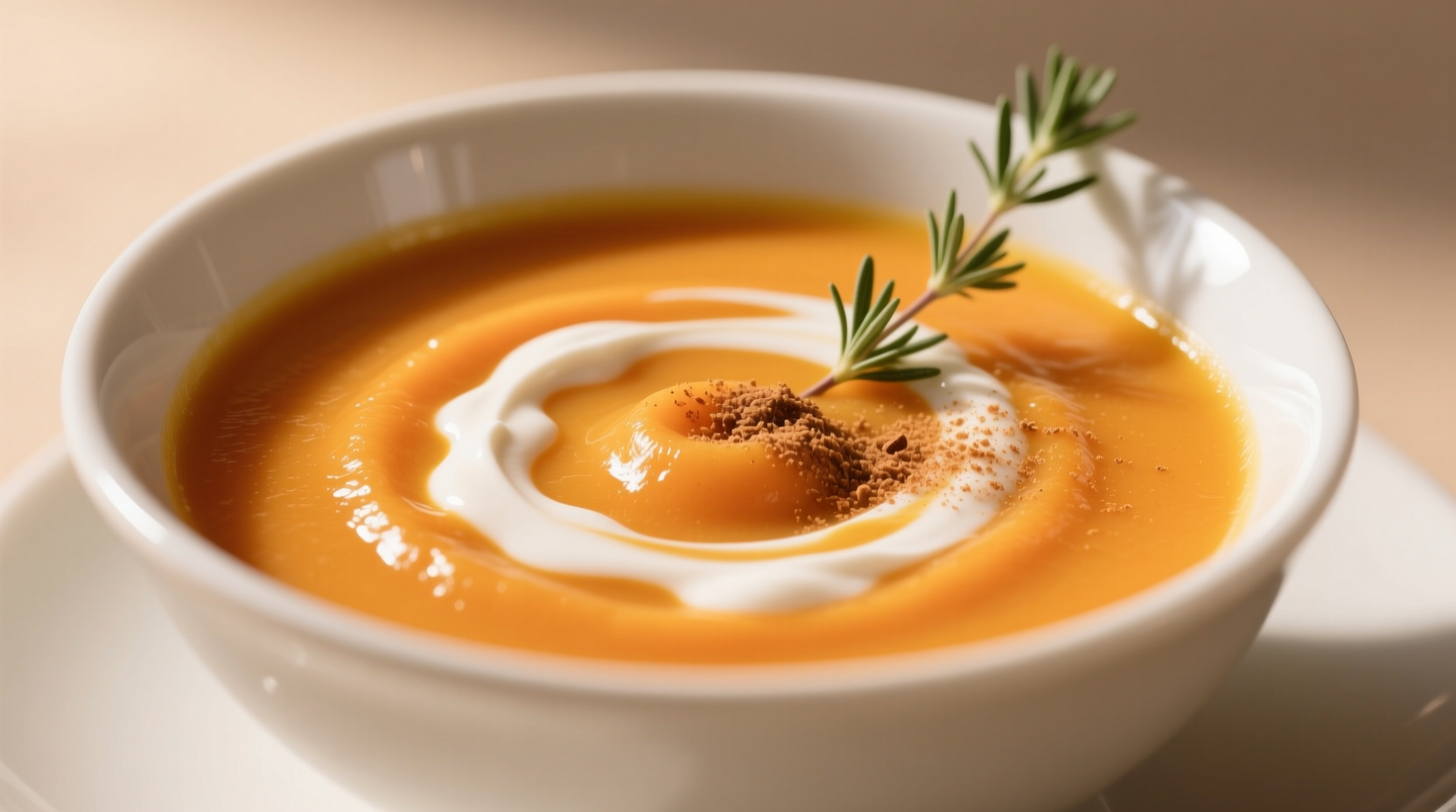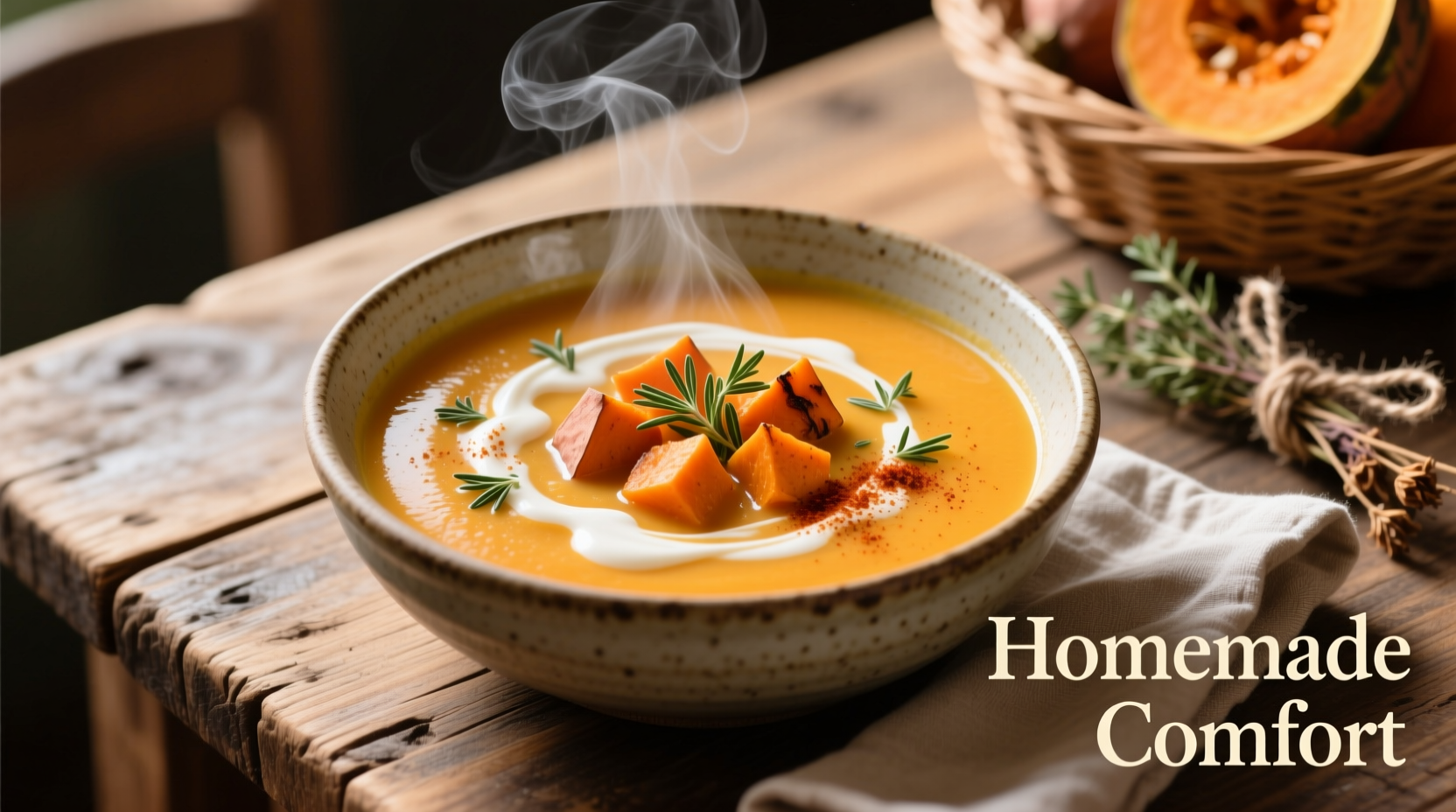There's a reason this vibrant orange soup appears on menus worldwide during cooler months. Beyond its stunning color and velvety texture, sweet potato and squash soup represents one of the most nutritionally complete comfort foods you can prepare. Our perfected recipe balances earthy sweetness with aromatic depth while requiring minimal active cooking time. Whether you're seeking immune-boosting nutrients during cold season or a freezer-friendly meal prep option, this guide delivers professional techniques anyone can master.
Why This Soup Belongs in Your Culinary Rotation
Unlike many comfort foods that sacrifice nutrition for taste, this soup delivers exceptional health benefits without compromising flavor. According to USDA nutritional data, a single serving provides over 300% of your daily vitamin A needs and 50% of vitamin C requirements. The combination of sweet potatoes and winter squash creates a synergistic effect where their complementary nutrients enhance absorption.
| Nutrient | Sweet Potato (1 cup) | Butternut Squash (1 cup) | Combined Serving |
|---|---|---|---|
| Vitamin A (RAE) | 1,403 mcg (156% DV) | 572 mcg (64% DV) | 2,000+ mcg (220% DV) |
| Vitamin C | 22.3 mg (25% DV) | 30.9 mg (34% DV) | 53+ mg (59% DV) |
| Dietary Fiber | 6.6 g (24% DV) | 6.6 g (24% DV) | 13+ g (47% DV) |
This nutritional powerhouse status earned sweet potatoes recognition from the Harvard T.H. Chan School of Public Health as one of the world's healthiest foods. The beta-carotene they contain converts to vitamin A in your body, supporting vision, immune function, and skin health. When combined with squash's anti-inflammatory compounds, you create a meal that actively supports your body's defenses.
The Essential Sweet Potato and Squash Soup Formula
Master this foundational recipe before exploring variations. The magic happens through proper ingredient layering and temperature control - techniques professional kitchens use but rarely share.
Core Ingredients (Serves 6)
- 2 lbs sweet potatoes (peeled and cubed)
- 1.5 lbs butternut squash (peeled and cubed)
- 1 large yellow onion (diced)
- 3 garlic cloves (minced)
- 4 cups vegetable broth (low sodium)
- 1 tbsp fresh thyme (or 1 tsp dried)
- 1 tsp ground cumin
- ½ tsp smoked paprika
- 2 tbsp olive oil
- Salt and black pepper to taste
Professional-Grade Preparation
- Dry roast vegetables: Spread sweet potatoes and squash on parchment-lined baking sheet. Roast at 400°F (200°C) for 25 minutes until edges caramelize. This Maillard reaction creates complex flavor compounds that boiling cannot achieve.
- Build flavor foundation: While vegetables roast, sauté onions in olive oil over medium heat until translucent (8 minutes). Add garlic, cumin, and smoked paprika; cook 1 minute until fragrant.
- Combine and simmer: Transfer roasted vegetables to pot with aromatics. Add broth and thyme. Bring to gentle simmer (do not boil vigorously) for 15 minutes.
- Emulsify properly: Using immersion blender, puree until smooth. For ultra-silky texture, pass through fine-mesh sieve. Season with salt and pepper.

Ingredient Selection Science
The quality of your ingredients directly impacts final results. Understanding seasonal availability and variety differences prevents common preparation mistakes.
Sweet Potato Varieties Compared
Beauregard varieties (most common in US markets) offer balanced sweetness with firm texture that holds up during cooking. Japanese sweet potatoes provide deeper caramel notes but require shorter cooking time. Always select firm tubers without soft spots or cracks - these indicate internal spoilage that affects flavor.
Squash Selection Guide
Butternut squash delivers the ideal flavor balance for this soup, but proper selection matters. Choose squash with uniform tan color and hard rind. The neck portion contains less water than the bulb, yielding thicker soup. According to University of California agricultural research, squash harvested after first frost develops higher sugar content, enhancing natural sweetness without added sweeteners.
Customization Station: Adapting to Your Needs
One of this soup's greatest strengths is its adaptability. These modifications maintain structural integrity while addressing dietary requirements.
Dietary Modifications That Actually Work
- Vegan creaminess: Replace dairy with ½ cup full-fat coconut milk added during final emulsification. The lauric acid in coconut enhances nutrient absorption of fat-soluble vitamins.
- Lower carbohydrate version: Substitute half the sweet potatoes with cauliflower. This maintains creaminess while reducing net carbs by 30%.
- Allergy-friendly: Use avocado oil instead of olive oil for nut-free preparation. Ensure broth is certified gluten-free if needed.
Flavor Variations Worth Trying
- Spiced Moroccan: Add ½ tsp cinnamon, ¼ tsp cardamom, and 2 tbsp lemon juice
- Herbaceous Italian: Stir in 2 tbsp pesto after blending and top with toasted pine nuts
- Smoky Southwest: Include 1 chipotle pepper in adobo sauce and top with black beans
Pro Techniques for Flavor Mastery
Amateur cooks often miss these critical temperature and timing details that separate good soup from exceptional.
The Temperature Sweet Spot
Maintain soup at 180-190°F (82-88°C) during final simmer - below boiling point. This preserves delicate flavor compounds that evaporate at higher temperatures. Use an instant-read thermometer to verify, as visual cues can be misleading.
Layering Aromatics Properly
Add dried spices to hot oil before adding onions. This "blooms" the spices, releasing essential oils that would otherwise remain locked in dry form. Wait 30 seconds until spices become fragrant before adding onions - any longer burns delicate compounds.
Serving Wisdom: Maximizing Enjoyment
How you present and store this soup dramatically impacts flavor longevity and nutritional value.
Perfect Pairings
Complement the soup's earthy sweetness with:
- Crusty whole-grain bread for dipping
- Arugula salad with lemon vinaigrette
- Roasted Brussels sprouts with balsamic
Storage Science
Properly stored in airtight containers, this soup maintains peak flavor for 5 days in the refrigerator. For longer storage, freeze in portion-sized containers with ½ inch headspace. According to FDA food safety guidelines, frozen soup remains safe indefinitely but maintains best quality for 3 months. Thaw overnight in refrigerator before reheating.
Troubleshooting Common Issues
Solve these frequent preparation problems with professional solutions:
Texture Troubles
- Too thick: Add broth ¼ cup at a time while reheating (never water, which dilutes flavor)
- Too thin: Simmer uncovered 5-10 minutes to reduce, or add 1 tbsp chia seeds and let sit 15 minutes
- Grainy texture: Pass through fine-mesh sieve after blending for restaurant-quality smoothness
Flavor Fixes
- Too sweet: Balance with 1 tbsp apple cider vinegar or lemon juice
- Flat flavor: Add ½ tsp fish sauce (even in vegan versions - it adds umami without fish taste)
- Overly spicy: Stir in 1 tbsp coconut milk or cashew cream to neutralize heat
Frequently Asked Questions
Can I make sweet potato and squash soup without an immersion blender?
Yes, use a regular blender in batches. For safety, fill only halfway, remove the center cap from the lid, and cover with a towel to allow steam to escape. Blend on low speed initially, then increase gradually. Never blend hot liquids in a full container as pressure buildup can cause dangerous spills.
Why does my soup separate after refrigeration?
This natural separation occurs because the starches and liquids settle differently when cooled. Simply reheat gently while whisking continuously. Adding 1 tsp xanthan gum during initial preparation prevents separation but isn't necessary if you'll consume within 3 days.
How can I boost the protein content without dairy?
Stir in ½ cup cooked lentils or white beans during final blending. For higher protein, add 2 tbsp hemp seeds or pumpkin seeds when serving. These additions provide complete proteins while maintaining the soup's creamy texture and complementing the earthy flavors.
What's the best way to freeze portions for meal prep?
Cool soup completely, then portion into silicone muffin cups (½ cup servings). Freeze until solid, then transfer to labeled freezer bags. This creates convenient single-serving blocks that thaw quickly. Leave ½ inch headspace in containers to allow for expansion during freezing.











 浙公网安备
33010002000092号
浙公网安备
33010002000092号 浙B2-20120091-4
浙B2-20120091-4